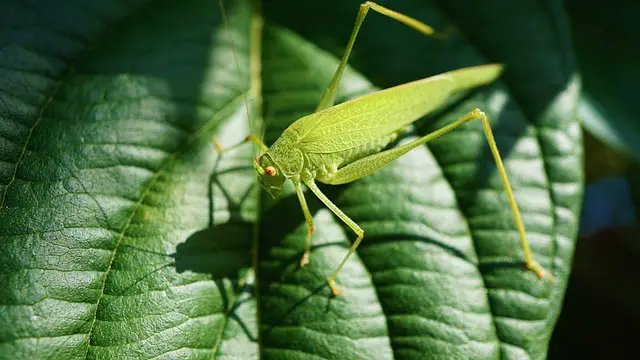Snakes are fascinating creatures that have been the subject of many myths and misconceptions. For example, one of the most common questions people have about snakes is what they eat. While some snakes are known for their preference for rodents, others have a more varied diet that includes insects, birds, and even other snakes.
One question that often arises is whether snakes eat grasshoppers. The answer is yes; many species of snakes do eat grasshoppers. In fact, grasshoppers are a common food source for many types of snakes, including garter snakes, rat snakes, and king snakes.
However, not all snakes eat grasshoppers. Some species, such as the venomous coral snake, prefer to feed on other types of prey.
Additionally, even among the snakes that do eat grasshoppers, there can be variations in their diet depending on their location and habitat.
Do Snakes Eat Grasshoppers?
Snakes are known to be carnivorous, and they eat a variety of prey, including insects, rodents, and other small animals. One of the insects that snakes eat is the grasshopper. In this section, we will explore the topic of snakes eating grasshoppers in detail.
What Kind of Snakes Eat Grasshoppers?
Many species of snakes eat grasshoppers. Some of the most common snakes that eat grasshoppers include garter snakes, king snakes, and rat snakes. These snakes are found in various parts of the world and are known to be opportunistic feeders, meaning they will eat whatever prey is available to them.
How Do Snakes Hunt Grasshoppers?
Snakes use various methods to hunt grasshoppers. Some snakes, such as garter snakes, actively hunt grasshoppers by chasing them down and catching them with their mouths.
Other snakes, such as rat snakes, use ambush tactics to catch grasshoppers. They wait for the grasshoppers to close and strike quickly to catch them.
Snakes have specialized jaws that allow them to swallow prey whole. They do not chew their food but instead use strong muscles to push the prey down their throats.
This means snakes can eat prey much larger than their heads.
Why Do Snakes Eat Grasshoppers?
Snakes eat grasshoppers because they eat other prey: to obtain the nutrients they need to survive. Grasshoppers are a good source of protein for snakes, and they are relatively easy to catch. Grasshoppers are also abundant in many parts of the world, which makes them a convenient food source for snakes.
In addition to providing nutrition, eating grasshoppers can also help snakes regulate their body temperature. Snakes are cold-blooded animals, which means that the environment around them regulates their body temperature. Therefore, eating grasshoppers can help snakes warm up on cooler days and cool down on hotter days.
What Happens When Snakes Eat Grasshoppers?
Snakes are known to be carnivorous creatures, and they have a wide variety of prey that they feed on. One of the most common prey items for snakes is grasshoppers. When snakes eat grasshoppers, several processes occur in their digestive system, and there are some benefits and risks associated with this feeding behavior.
Digestion Process
When a snake eats a grasshopper, it swallows it whole. The grasshopper then travels down the snake’s esophagus and enters the stomach. In the stomach, digestive enzymes break down the grasshopper’s exoskeleton and other tough parts. The nutrients from the grasshopper are then absorbed into the snake’s body.
After digestion, snakes will excrete waste in the form of feces. The feces will contain undigested grasshopper parts, such as the wings and legs.
Benefits
Grasshoppers are a good source of protein for snakes. Protein is essential for the snake’s body’s growth, repair, and maintenance. Eating grasshoppers can also provide snakes with crucial vitamins and minerals.
In addition, snakes that eat grasshoppers may have a lower risk of contracting certain diseases. This is because grasshoppers are less likely to carry parasites and pathogens that can harm snakes than other prey items.
Risks
While grasshoppers are generally safe for snakes, some risks are associated with this feeding behavior. For example, grasshoppers may contain toxins that can be harmful to snakes.
Additionally, snakes that eat grasshoppers exclusively may not get a balanced diet. A diet that is too high in protein and low in other nutrients can lead to health problems in snakes.
Finally, snakes that eat grasshoppers may be at risk of ingesting pesticides. Grasshoppers exposed to pesticides can accumulate these chemicals in their bodies, and if a snake eats a contaminated grasshopper, it may also be exposed to the pesticide.
Conclusion
While not all species of snakes consume grasshoppers, many do, and it is a common part of their diet. As a result, grasshoppers are a good source of protein for snakes, and they are readily available in many habitats.
It is important to note that snakes do not rely solely on grasshoppers for their diet. They are opportunistic predators and will consume a variety of prey, depending on what is available in their environment. Additionally, the size and species of snake will determine the size and type of prey they consume.
Overall, it is safe to say that grasshoppers are part of a snake’s diet, but they are not the only food source. Snakes play an important role in the ecosystem, and their consumption of grasshoppers can help regulate populations of these insects in the wild.




